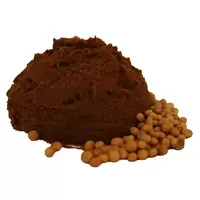Soy paste

Soy paste, like any other soybean-based product, is hugely popular in the Asian region. However, the most loyal and ardent fans of all types of soybean paste are residents of Korea, Japan, as well as China. In the culinary tradition of all three countries, there are not a single hundred recipes for soybean paste. Typically, the soybean paste is made from pre-refined and fermented soybean beans.
However, in some recipes, garden beans are added to soy paste. Soybeans undergo a fermentation or fermentation process, which is the metabolic breakdown of naturally occurring raw material molecules, in this case soybeans roam. The result is a healthy and vitamin-rich product. The chemical composition of the soybean paste depends on the variety of product.
In addition, the caloric value and vitamin-mineral composition of the soybean paste are influenced by the initial set of ingredients that are used in the process of making the product. Any kind of soybean paste will be distinguished by its characteristically salty taste, which in the Asian culinary tradition has its own special name - the taste of umami 旨味 or the taste of protein substances, as well as the "fifth taste. " Umami does not have a material incarnation in sauce, it is a kind of feeling that is inherent in most dishes of traditional Japanese, Korean and Chinese cuisine.
It is noteworthy that soy paste acquires its distinctive taste thanks to sodium glutamate, which is abundant in the composition of the product. Soy paste has found wide application in cooking, the product is used as an ingredient in the process of preparing soups, main dishes, as well as snacks. Over the centuries-old existence in the Asian culinary tradition, several hundred recipes for various soy pastes have accumulated, which differ not only in taste, but also in the field of application.
Among the most common and widely used soy pastes are the following:
Japanese miso soy paste;
Chinese soy paste dochi;
Chinese soy paste doujiang;
Korean soybean paste twenjang;
Korean soybean paste tyong;
Korean soybean paste Cheonggukjan.
It is worth noting that the above list with the listed types of soy pastes can only be called the tip of the culinary iceberg. In addition, soy paste can be classified depending on the color of the product. Light or dark soy paste is found. Moreover, the color of light soy paste can be white, dairy, creamy and even yellow.
Dark soy paste also differs in color. There is a light brown or dark, sometimes burgundy soy paste. Most famous sauces are made from soy paste, which is considered a hallmark of the Asian culinary tradition.
soy paste 197.1 kCal
Energy value of soybean paste (Ratio of proteins, fats, carbohydrates - ju):
Proteins: 12.3 g (~ 49 kCal)
Fats: 5.5 g (~ 50 kCal)
Carbohydrates: 24.6 g (~ 98 kCal)
Energy ratio (bj | y): 25% | 25% | 50%
 Español
Español Français
Français Português
Português Русский
Русский 简体中文
简体中文 繁體中文
繁體中文 日本語
日本語 한국어
한국어 العربية
العربية Türkçe
Türkçe Қазақ
Қазақ Deutsch
Deutsch Italiano
Italiano Українська
Українська
